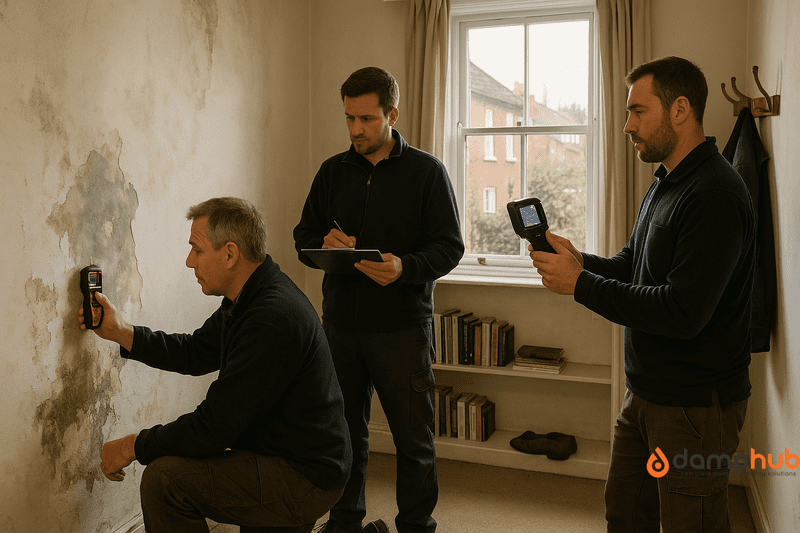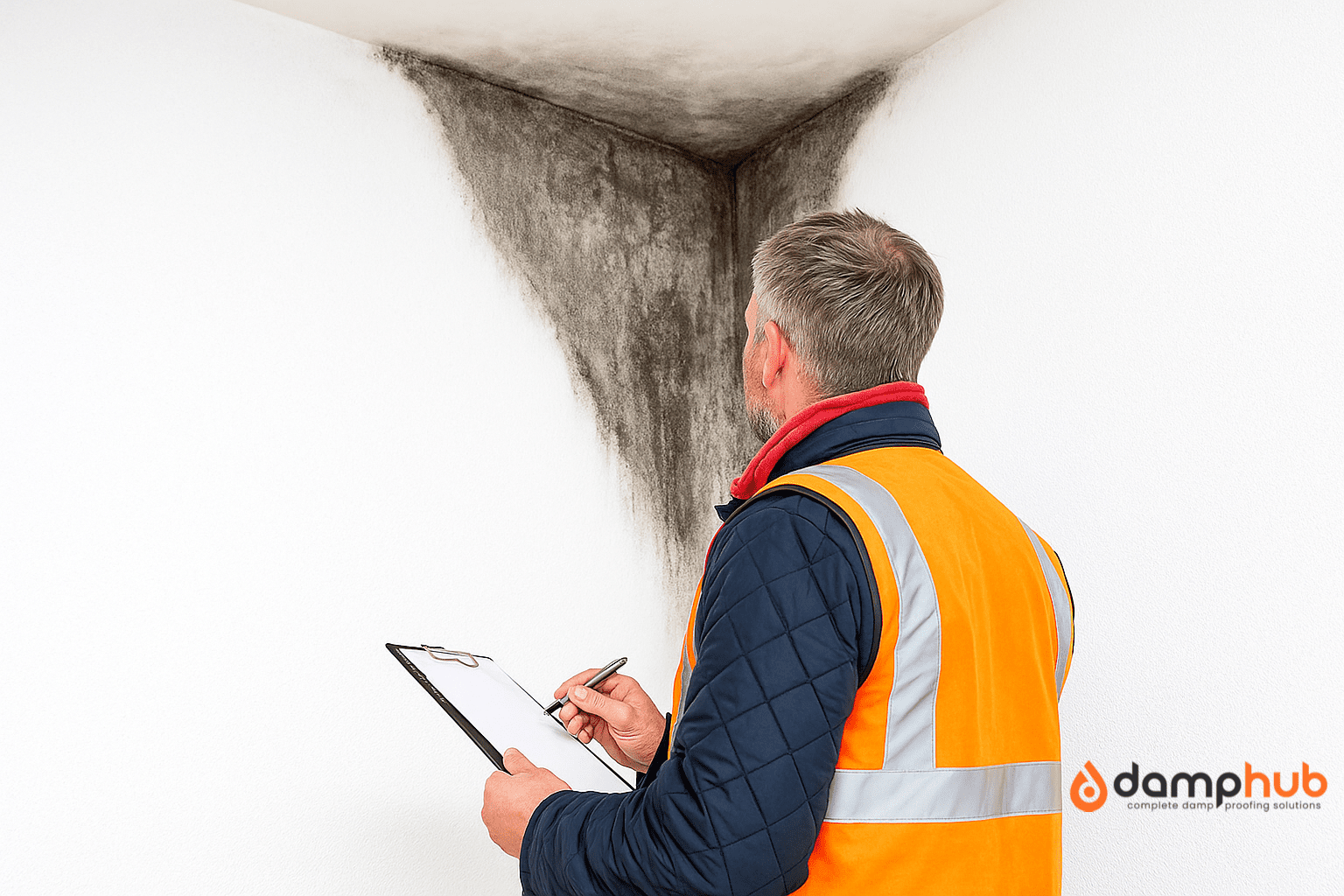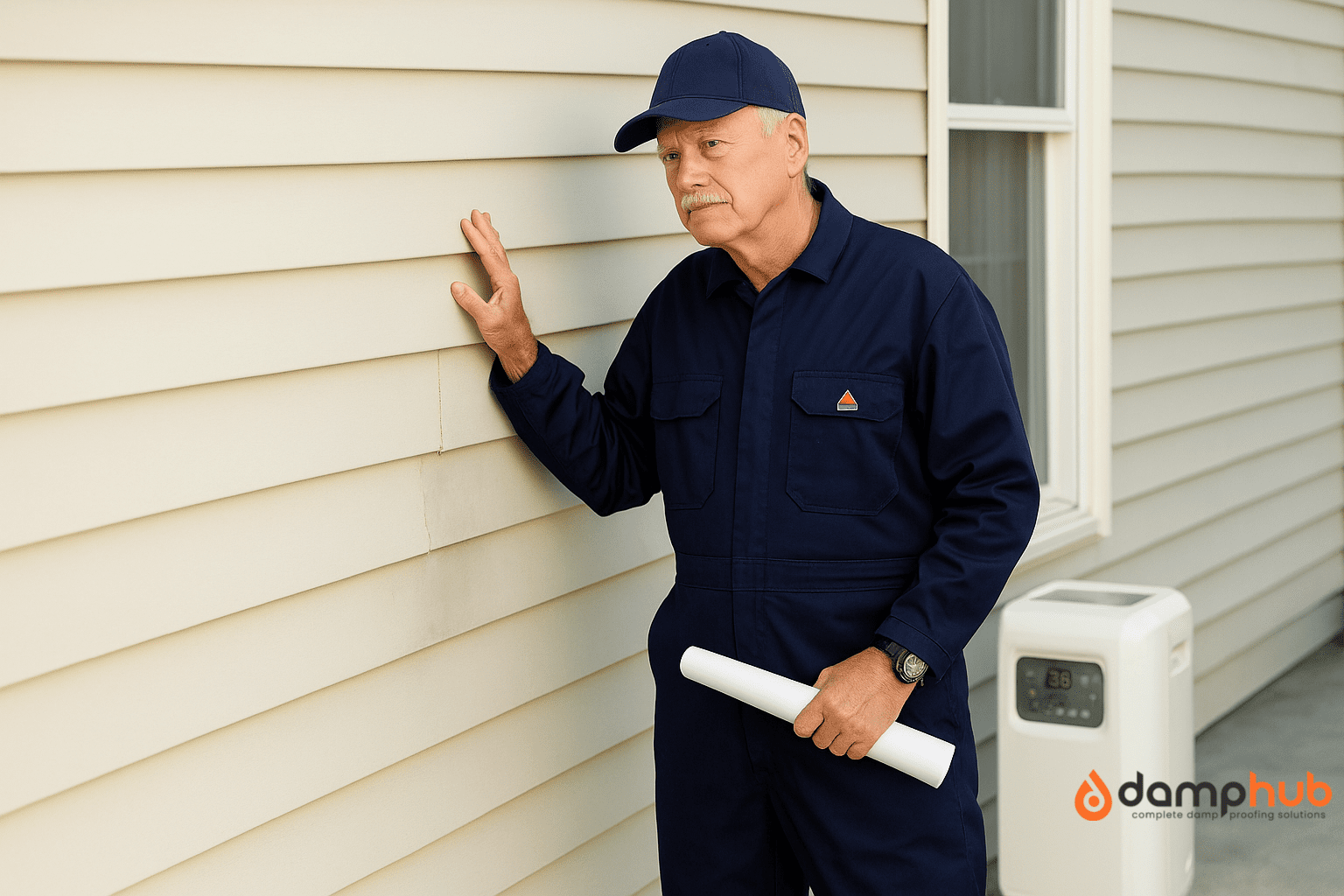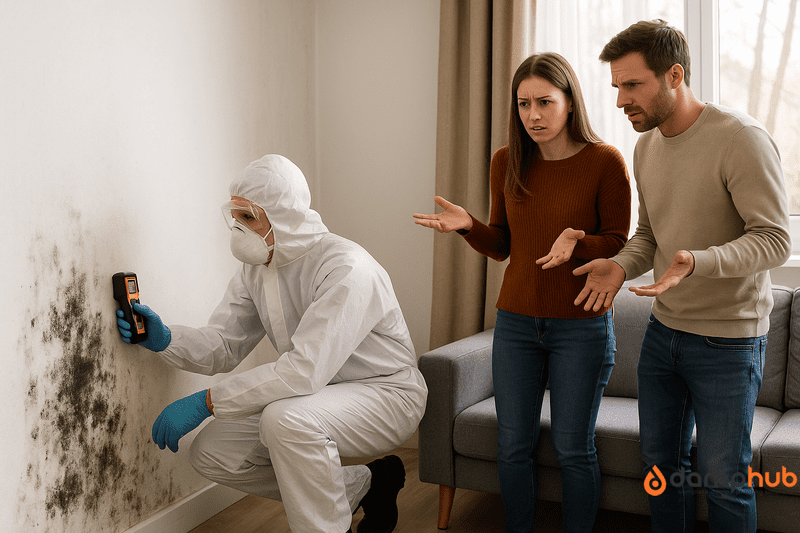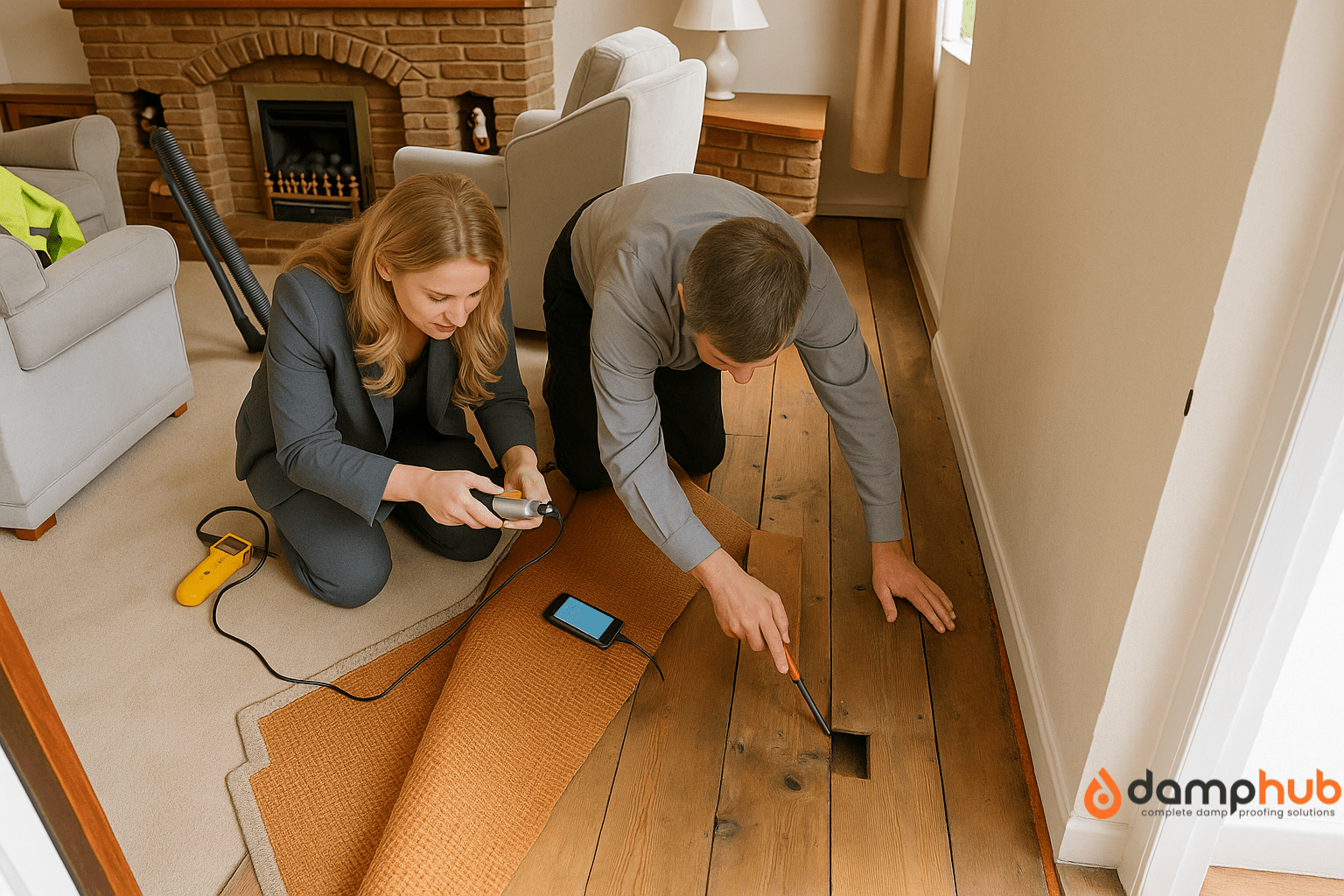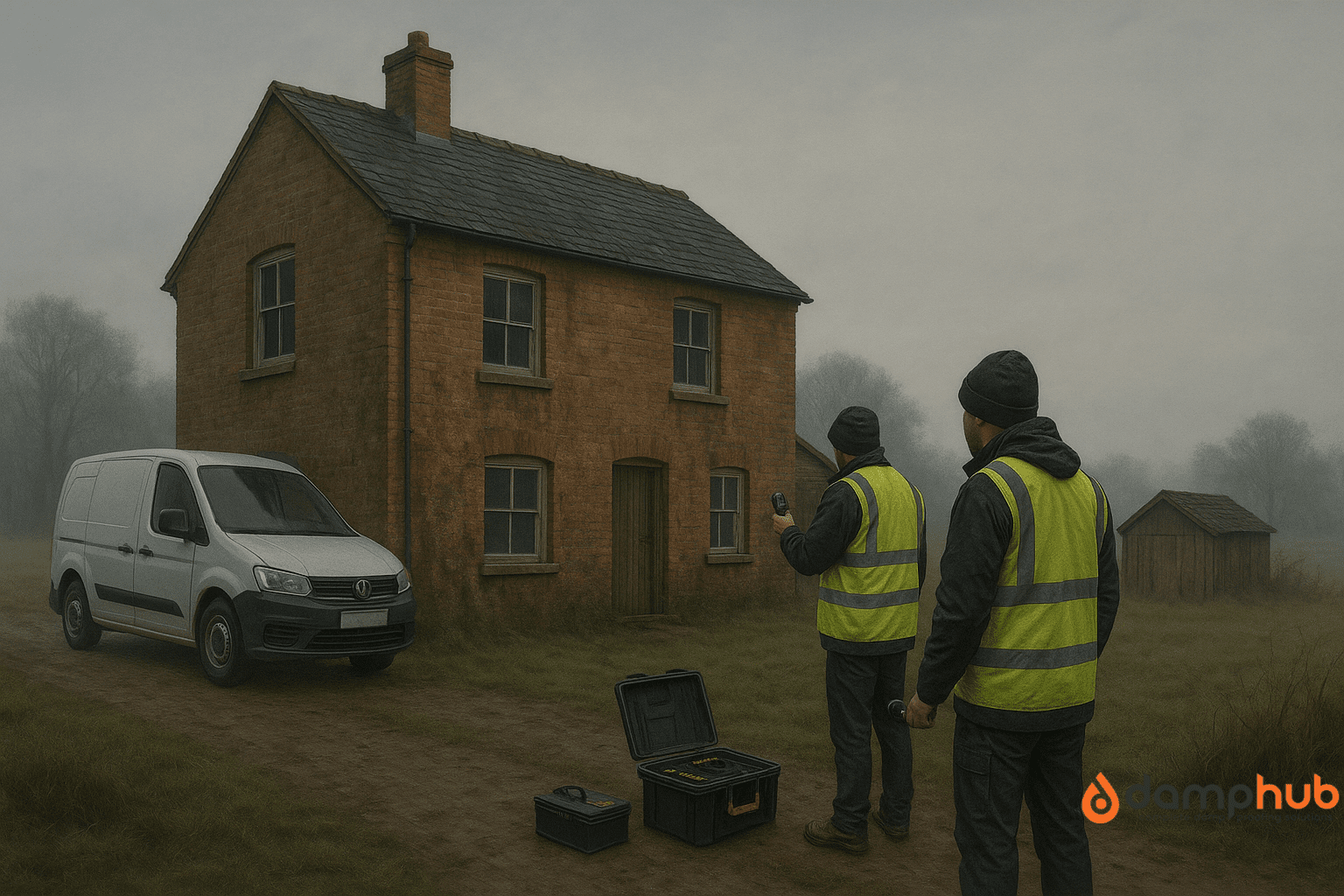
Key Takeaways
Key Takeaways
- ✓ Damp and timber reports highlight hidden structural issues that may not show up in a standard survey.
- ✓ They’re often required during property sales to satisfy lenders, insurers, or cautious buyers.
- ✓ Common problems include wood rot, mould, excess moisture, or insect attack — all of which can weaken a building over time.
- ✓ Surveyors use specialist tools to diagnose the type of damp or decay and recommend how to deal with it.
- ✓ Getting a report early can prevent costly delays, price drops, or nasty surprises down the line.
If you’re buying a property or trying to sell one, you’ll probably hear someone suggest getting a damp and timber report. And at first glance, it might sound like just another form to tick off the list. But it’s more important than that.
Damp and timber issues are among the most common reasons house sales fall through. They’re also some of the most expensive to fix after you move in.
What looks like a small patch of mould could be a sign that water’s getting in somewhere. A slightly bouncy floorboard? It might mean the joists underneath are rotting out or riddled with beetle holes.
These aren’t problems you want to guess at. A damp and timber report gives you proper answers. It checks the structure for signs of moisture damage, rot, or infestation — and more importantly, it explains why it’s happening, how bad it is, and what needs doing.
Whether you’re a buyer who doesn’t want to inherit someone else’s neglect, a seller trying to avoid surprises during the conveyancing process, or a homeowner wondering if that black patch behind the sofa is harmless or not, this report gives you clarity.
In the rest of this guide, we’ll walk you through what a damp and timber report includes, how it’s done, when you need one, and what to do with the results once you’ve got them.
👉 Read more from us: What is included in a Damp Survey?
What Is a Damp and Timber Report?
A damp and timber report is a specialist survey designed to identify damp, rot, and woodworm issues in a property. It’s often required by lenders or buyers during mortgages, re-mortgages, or property purchases to ensure the property is safe and structurally sound.
The report entails:
- Visual Inspection: Our surveyor will look for visible signs of damp, mould, and timber decay or insect infestation.
- Moisture Detection: They use tools such as moisture meters, hygrometers, and thermal imaging cameras to detect and map hidden moisture within walls, floors, and ceilings.
- Timber Assessment: The surveyor checks structural timbers for decay, such as dry rot or wet rot, and signs of wood infestation.
- Specialist Testing: For more definitive results, chemical carbide tests may be performed on masonry samples to measure their total moisture content.
In the UK, you’ll usually need a damp and timber report:
- As part of a mortgage or pre-purchase survey
- When you notice issues like damp smells, black mould, or flaky plaster
- If a previous survey flagged “possible timber defects”
- Or when a property’s been treated before and you want to check if it’s worked
Good to Know:
This report isn’t a generic damp check. It’s specific. It tells you what’s happening, where, why, and what to do next, which is what makes it so useful for buyers, sellers, and owners alike.
Why Damp and Timber Issues Matter
Damp and timber issues matter because they can compromise a building’s structural integrity and create long-term health, safety, and resale problems.
Left unchecked, damp gets into walls, ceilings, floors, and wooden structures. Over time, it causes timber to rot, plaster to crumble, and internal finishes to deteriorate. It also creates ideal conditions for mould growth, which can lead to respiratory issues, especially in children and vulnerable adults.
But it’s not just the obvious damage. Timber decay can happen slowly and silently. Floor joists can rot beneath carpets, roof timbers can soften from condensation in a loft, and decorative woodwork can hide insect attack for years.
Here’s why it matters:
- It gets worse if ignored – Most damp-related issues spread gradually, affecting larger areas and more materials over time.
- It’s expensive to put right – Replacing rotten joists or treating dry rot is far more costly than tackling it early.
- It affects property value – Buyers will walk away, or chip thousands off the asking price, if there’s a hint of structural decay.
- It impacts mortgages and insurance – Lenders often won’t release funds unless damp and timber issues are assessed — and sometimes fixed — first.
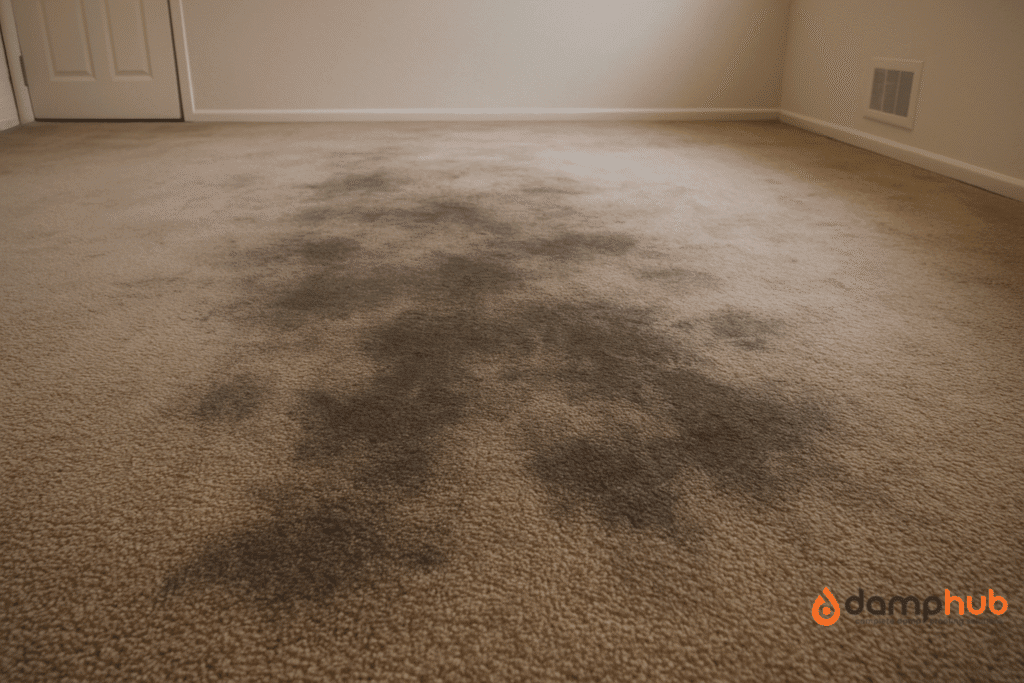
Try This:
If your home smells musty after it rains or you’ve got persistent black mould in the same few corners, don’t just clean it off. Those are warning signs — not surface problems. A proper survey gives you the real story.
What’s Inspected During a Damp and Timber Survey?
A damp and timber survey inspects a property for signs of moisture damage and timber decay, focusing on structural elements like walls, floors, and roof timbers. The goal is to locate problems such as damp patches, rotting joists, fungal growth, or insect infestation, and to identify what’s causing them.
Areas typically inspected include:
- Internal and external walls: Surveyors check for visible damp patches, peeling paint, blown plaster, or white salt deposits — all signs that moisture might be coming through the walls. Outside, they’ll check pointing, render, and wall finishes for cracks or water ingress points.
- Floors and subfloor voids: Suspended timber floors are closely inspected, especially if there’s a musty smell or bounce underfoot. Surveyors may use probes to check joists, look for wet rot or beetle holes, and assess whether the airflow beneath the floor is adequate.
- Skirting boards, architraves, and internal joinery: Timbers along the bottom of walls are often the first to show signs of damp — surveyors press or prod them to check for softness, flaking paint, or fungal growth that points to rot.
- Lofts and roof spaces: Roof timbers, purlins, and insulation are examined for signs of water staining, rot, or beetle activity. Poor ventilation in these areas often causes condensation-related decay, especially in winter.
- Basements and cellars: These areas often hide long-term problems. Surveyors will check for standing damp, stained walls, high humidity, or mould. These spaces are particularly vulnerable to rising damp and condensation.
- Windows, doors, and lintels: Wooden windows and doorframes can suffer from wet rot or decay where rainwater collects. Surveyors also check for distorted frames or signs of movement that might be linked to hidden damp.
- Ventilation and airbricks: A damp property without airflow won’t dry out. Surveyors will look for blocked or missing airbricks, sealed chimney breasts, or inadequate ventilation in kitchens and bathrooms — all of which can trap moisture inside.
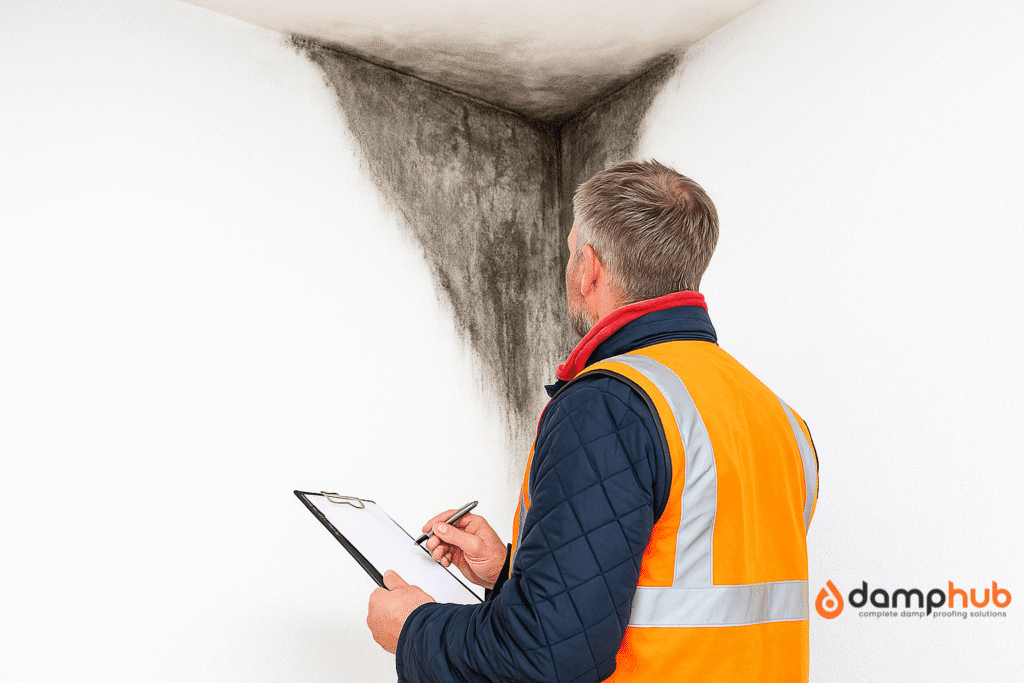
Pro Tip:
Before your survey, clear out any blocked access points — like under-stair cupboards, attic hatches, or cluttered corners — so the surveyor can do a proper job without guessing.
👉 Read more from us: Is It Worth Paying for a Damp Survey?
What Testing Methods Are Used in a Damp and Timber Report?
Damp and timber surveys use tools like moisture meters, borescopes, and salt tests to confirm the presence and cause of damp or decay. These tests provide data that supports the surveyor’s diagnosis, helping them separate harmless issues from serious ones.
Common testing methods include:
- Moisture meters: Used to check the moisture content inside walls, timbers, and floors. Deep-probe meters allow the surveyor to assess what’s happening beneath the surface — useful when visible signs are subtle or patchy.
- Salt analysis (nitrates/chlorides): Identifies the presence of salts that are carried up by groundwater in cases of rising damp. Helps distinguish between condensation and true rising damp, which require very different treatments.
- Borescope inspection: A flexible camera inserted through small holes to visually inspect hidden spaces (like wall cavities, floor voids, or behind timber panelling). Allows for a closer look without major disruption.
- Hygrometer readings: Measures relative humidity in the air — high levels suggest condensation risk, especially in bathrooms, kitchens, or rooms with little ventilation. Used to determine if lifestyle factors (not leaks) might be causing damp.
- Thermal imaging (when used): Shows cooler patches that may indicate trapped moisture or poor insulation. Useful for mapping damp patterns or spotting missing insulation that’s causing cold bridging.
- Visual ID and physical testing: Some signs don’t need machines. Trained surveyors know how to spot dry rot mycelium, woodworm frass, or early fungal bloom. They’ll gently prod timbers with a screwdriver or knife to assess firmness and decay without damaging them.
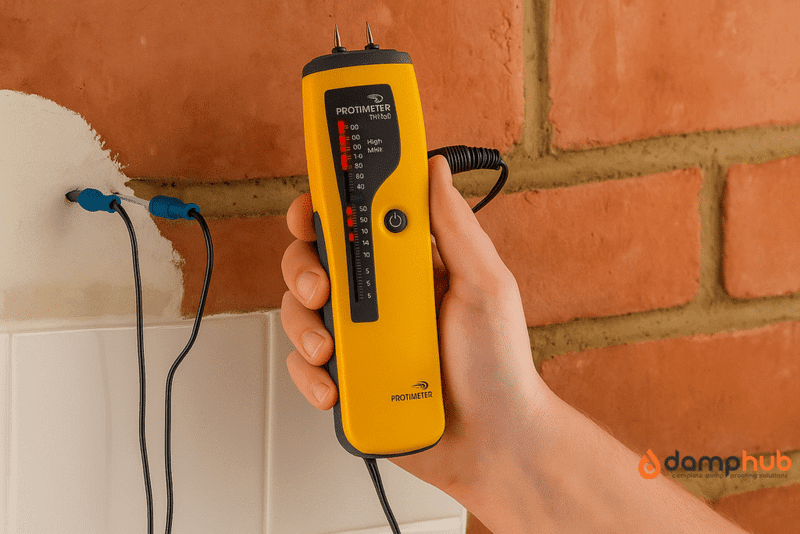
Good to Know:
One moisture reading on its own means very little. It’s the context that counts — is the wall cold? Is there airflow? What’s on the other side? The best surveyors use tools to confirm what their experience already suspects, not the other way round.
Also see related posts from us 👉 10 Best Damp Survey Companies in London
What Happens If You Ignore a Damp and Timber Report?
If you ignore the findings of a damp and timber report, the problems are likely to get worse, leading to structural damage, higher repair costs, reduced property value, and potential issues with insurance or resale.
It’s not scare tactics. It’s just how buildings behave. Damp doesn’t stay still. Timber decay doesn’t fix itself. And once moisture takes hold, it rarely fades quietly into the background.
Here’s what can happen if you leave it:
1. The damage spreads — and it spreads silently
That slightly soft skirting board might seem harmless now, but if it’s damp from the inside out, it could be feeding a slow chain reaction through adjacent timbers or walls.
Dry rot, in particular, is notorious for spreading through masonry, often undetected until floors start to give way or walls crack.
Rot affects strength. Joists can fail. Ceilings can sag. Floorboards can snap under pressure. This isn’t about aesthetics — it’s about structural safety.
2. It costs more to fix the longer you wait
What could’ve been resolved with a £200 ventilation fix might end up needing £3,000 worth of timber replacements. Once wood is structurally compromised, there’s no patching it. It has to go.
And the longer damp is left, the more surfaces it contaminates — meaning more labour, more materials, and possibly redoing cosmetic work like replastering or decorating.
3. It affects saleability
If you’re planning to sell the property, any buyer’s survey will likely find the same issues. Only now, you’re on the back foot.
You’ll either have to fix the problem quickly (and possibly expensively) or accept a lower offer to compensate.
In some cases, buyers walk away entirely. Especially if mortgage lenders see active timber decay or untreated rising damp, which they often treat as a red flag.
4. It can cause health problems
Dealing with damp at home isn’t just unpleasant — it’s unhealthy. Black mould, spores from fungal growth, and stale, humid air can all impact breathing. This is particularly risky for children, the elderly, or anyone with asthma or a compromised immune system.
It’s not just about visible mould either. Moisture behind walls and under floors can still affect air quality throughout the home.
5. Insurance might not cover the consequences
Most UK home insurance policies don’t cover gradual deterioration. If damage worsens because you didn’t act on a professional report, insurers can argue that it was preventable and decline the claim.
Even if they do cover it, many will require proof that you took reasonable action to investigate or maintain the issue. A report ignored doesn’t tick that box.
6. You lose negotiating power
Whether you’re buying or selling, knowledge is power. If a report flags an issue and you don’t address it, you lose your leverage in any future deal. Buyers will ask, “Why hasn’t it been sorted?” and adjust their offer — or their interest — accordingly.
👉 For more information, please read: How Much Can Damp Devalue Your Home?
Do You Legally Need a Damp and Timber Report?
There’s no blanket legal requirement to get a damp and timber report, but in the UK, it’s often a condition for mortgage approval, insurance cover, or when dealing with listed or older properties.
So no, you won’t be arrested for skipping one. But in many cases, the people involved in the transaction (lenders, insurers, buyers) will insist on it before anything moves forward. And if they don’t ask for one, you might still want it for peace of mind.
When you’re buying a property
If a building survey or mortgage valuation raises red flags — say, mentions of “high moisture readings” or “suspected timber decay” — the lender may request a specialist damp and timber report. And they won’t proceed until it’s done.
Some buyers choose to get one pre-emptively, especially with older properties, coastal homes, or places that have been empty for a while.
It can protect your deposit, your sanity, and your budget. You’ll know what you’re walking into before you sign anything.
For listed buildings or heritage properties
If you’re buying or renovating a listed building, your conservation officer may require a damp and timber report before they approve certain types of work, especially if that work affects the structure, ventilation, or finishes.
Heritage properties often behave very differently from modern builds. The wrong kind of damp treatment (like cement-based injection systems) can actually make things worse. A proper report helps you do things the right way — and prove that to the council.
If the mortgage lender asks for one
This is common. Even if you’ve had a full structural survey, a lender may want a specialist damp and timber inspection as a follow-up.
They’re trying to protect their investment — and avoid lending on a property that might require major repairs.
Refuse it, and they may reduce the loan amount or withdraw the offer altogether.
When applying for certain grants or funding
Some energy efficiency or repair grants — especially through local councils — ask for supporting evidence, including damp-related reports. This proves that the problems are structural, not cosmetic, and helps guide appropriate repair work.
👉 Must Read: How Do I Choose a Damp Surveyor?
Insurance-related inspections
In some cases, home insurers or loss adjusters may request a damp and timber report before they agree to cover existing damage or extend policies for certain risk categories. This is particularly common for:
- Older homes with a history of water ingress
- Properties that have been unoccupied for long periods
- Homes with previous claims involving mould or timber repairs
If you’re selling and want to pre-empt problems
While not legally required, getting a damp and timber report before listing a property can be a smart move, especially if you suspect issues. It allows you to fix things ahead of time, or price the property accordingly, rather than scrambling during conveyancing.
Good to Know:
Some sellers include the report in their property pack, which can speed things up and reassure buyers. It shows transparency, and it often stops “subject to survey” negotiations dead in their tracks.
So, is it legally required?
Not by law, but often by circumstance. And if a lender, buyer, or local authority asks for one, you won’t get very far without it.
In short: it’s one of those things you can skip — until you can’t.
How to Get a Damp and Timber Report
If you need a damp and timber report, the first step is finding someone who actually knows what they’re doing, not just someone trying to sell you a treatment.
These reports are typically carried out by qualified surveyors who specialise in diagnosing damp and timber issues. Think: moisture problems in walls, signs of rot in floorboards, or insects burrowing into roof timbers.
Most people get one when buying or selling a house, or when something suspicious shows up, like crumbling skirting, musty air, or a patch that never dries.
Here’s how to get the report done properly, from start to finish.
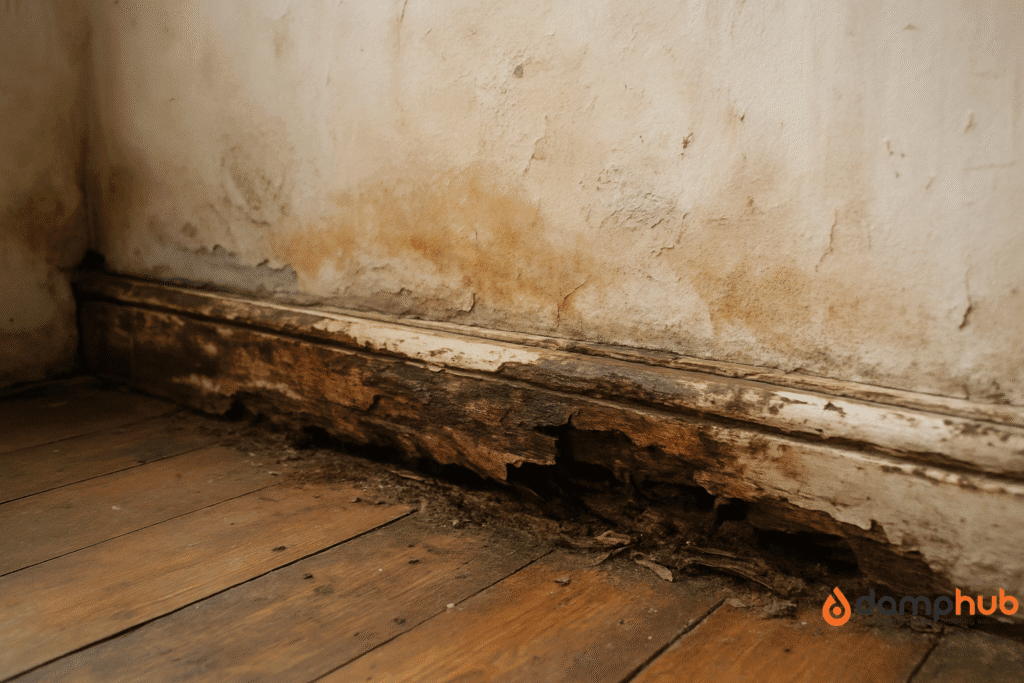
1. Decide who it’s for
Are you buying a house and want to check it’s not falling apart under the floorboards? Selling and want to get ahead of any nasty surprises? Or maybe you’ve just found mould behind the wardrobe and need to know what you’re dealing with.
Knowing the purpose helps. For example:
- Mortgage lenders might ask for a report from a PCA-registered specialist
- If you’re the buyer, it gives you the power to negotiate
- If you’re the seller, it helps avoid delays or haggling later
- Landlords often use them to check on older properties between tenancies
2. Find the right person, not just the cheapest
Search for a qualified damp surveyor, ideally someone with PCA or CSRT credentials. These professionals inspect homes without being tied to a treatment company. You want someone who’ll give you facts, not a sales pitch.
Be wary of “free surveys”. These often come with strings attached. The report might only exist to justify costly work. It’s not independent.
Try searching:
- “Independent damp surveyor near me”
- “PCA damp and timber surveyor [your town]”
- “CSRT timber surveyor mortgage report”
Look for clear pricing, reviews, and examples of past reports. If they can’t show you one, that’s a red flag.
3. Book the survey
Once you’ve found someone reputable:
- Give them a call or fill out their online form
- Say whether you’re the owner, buyer, or agent
- Explain what you need the report for — mortgage, insurance, peace of mind, or negotiation
- Let them know about any access issues (e.g., tenants in place, sealed floors, no loft ladder)
Most surveys take around 1 to 2 hours, depending on the size and complexity of the property.
4. Get the property ready
To help the surveyor do a thorough job:
- Move furniture away from any problem areas (walls, skirting boards, vents)
- Make sure lofts and floor hatches are accessible
- Don’t try to hide damp — it doesn’t work, and they’ll spot it anyway
- Have basic info ready, like the age of the property or previous works
You don’t have to be home during the inspection, but it’s worth being there if you can. You’ll pick up loads just by watching what they check.
👉 Must read: What Is a Damp Survey—And Should You Bother?
5. What happens on the day
The surveyor will go room to room, using a mix of tools and visual checks. They might use:
- A moisture meter
- Borescope (for looking into wall/floor cavities)
- Salt test kits (to check for rising damp)
- Thermal imaging (to spot hidden cold spots or leaks)
They’ll check obvious things like walls and ceilings — but also less visible parts like floor voids, roof timbers, and ventilation points. Expect them to take photos, readings, and notes throughout.
If you’re present, they may walk you through what they’re finding. If not, it’ll all be in the report.
6. When you get the report
Most companies send the full report within a few working days. A proper damp and timber report should include:
- A clear summary of what’s been found
- Where the issues are (room-by-room)
- What’s causing them
- What happens if you leave them
- Photos and readings
- Straightforward recommendations
It should also note any areas they couldn’t check — for example, a locked loft or sealed flooring.
Keep this report safe. It can be used during mortgage applications, for insurance purposes, or to get quotes from contractors.
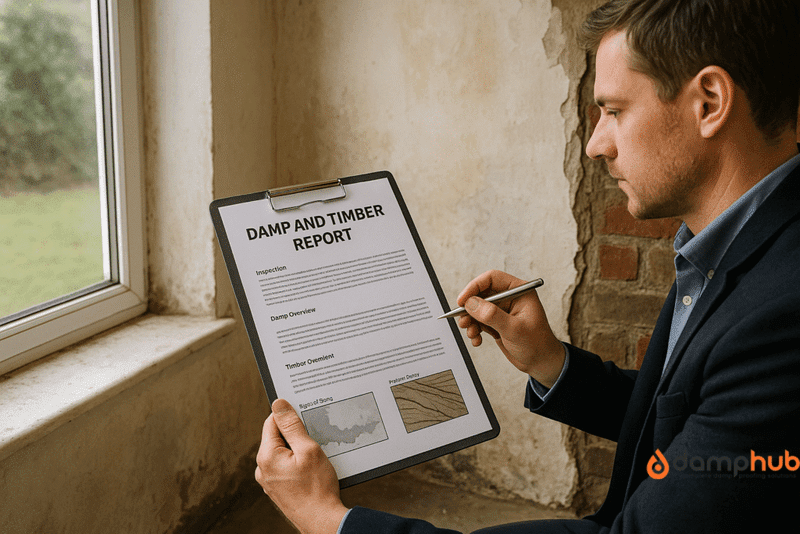
7. How much does a damp and timber report cost?
Expect to pay £150 to £400, depending on where you live and the size of the property.
In a sale, the buyer usually pays. But sellers sometimes get them done early to speed up the process or reassure buyers.
Don’t rely on free surveys unless you already trust the company. Paid, independent reports are far more useful — and much more respected by lenders and solicitors.
8. What to do after the report
Once you’ve read it:
- Share it with your solicitor, buyer, estate agent, or mortgage provider
- Use it to get accurate quotes for repairs, based on evidence
- Use it to challenge a low offer or justify one
- Or — if everything looks fine — relax and move forward with more confidence
If treatment is recommended, don’t rush. Get a few quotes. Compare what the contractors say with what’s actually in the report. A good contractor will echo the findings, not invent new ones.
In short:
Getting a damp and timber report is straightforward, but it matters who you ask. Choose someone qualified, make the property accessible, and use the findings properly. Whether you’re buying, selling, or staying put, it’s one of the best ways to avoid being caught out by problems hidden in the woodwork.
Quick Recap
- ✓ Don’t rely on guesswork — get damp checked by a professional.
- ✓ Never accept a “free” survey if it’s tied to a treatment company.
- ✓ If you’re buying, don’t skip this — it could save you thousands.
- ✓ Sort damp before you sell — or expect buyers to walk.
- ✓ Act early — damp only gets worse, never cheaper.
Frequently Asked Questions on Damp and Timber Report
Who pays for a damp and timber report?
The buyer usually pays for the report, especially if it’s requested during a property purchase or mortgage process.
In some cases, the seller might commission one in advance to reassure buyers or speed up a sale, but that’s less common.
What is a damp and timber report for PCA?
It’s a damp and timber report carried out by a surveyor registered with the Property Care Association (PCA).
Lenders and insurers often require PCA-backed reports because they follow recognised standards. They’re considered more reliable than general surveys.
How long does a damp and timber report take?
The survey takes an average of 3 to 4 hours on site, and the written report is usually delivered within 2 to 5 working days.
Larger or older properties may take longer to inspect or report on. Read our full guide here: How Long Does a Damp Survey Take? A Step-by-Step Timeline
What does a damp and timber survey look like?
It’s a room-by-room inspection using tools like moisture meters, borescopes, and cameras to check for damp and timber decay.
The surveyor will document findings and produce a written report with photos, test results, and recommendations.
How do you know if a property has damp?
Common signs include musty smells, black mould, flaky plaster, and cold, damp patches on walls or ceilings.
White salt marks, warped wood, or rotting skirting boards are also strong indicators.
How do surveyors detect damp?
They use moisture meters, salt tests, borescopes, and thermal cameras to find and measure damp within walls, floors, and timbers.
They also rely on visual inspection and experience to identify likely causes.
Who carries out damp surveys?
Qualified damp surveyors carry out these inspections — often PCA members or CSRT-certified professionals.
Choose someone independent if you want a report without sales pressure. For more information, read our full guide Who Can Carry Out a Damp Survey?

